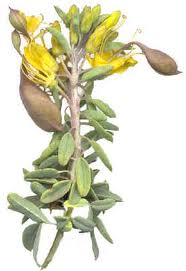Mid-Columbia farmers and private landowners won't be expected to protect the White Bluffs bladderpod, a plant species the federal government will list as being threatened. A federal designation of critical habitat goes into effect today , but only on federal land, officials said. The U.S. Fish and Wildlife Service proposed extending protection last year to the plant's habitat on 315 acres of private land in Franklin County, mostly farms, and 66 state-owned acres. However, Franklin County farmers and public officials were critical of the agency's proposal and the process. They threatened legal action and hired University of Idaho DNA researcher Cort Anderson, who disagreed with Fish and Wildlife's view that the plant is a distinct subspecies. But in its report, Fish and Wildlife said Anderson studied only three samples of White Bluffs bladderpod, not enough to change a peer review group's opinion. "The results from that peer review were unanimous," said Bridget Moran, Fish and Wildlife's consultation and conservation planning division manager. The agency didn't see the need to do its own DNA study and didn't have the funding for it, Moran said.
McMullen said Fish and Wildlife has budgeted more than $600,000 on protecting the bladderpod this year, which makes him wonder why it can't afford to do the research. The test cost the farmers $25,000.
'Nothing was going to stop them'
U.S. Rep. Doc Hastings, R-Pasco, is encouraged that Fish and Wildlife backed off its plan to designate private land as critical habitat, but still has serious concerns about how the decision was reached, he said.
Hastings, chairman of the House Natural Resources Committee, held hearings on the bladderpod and other endangered species issues in Washington, D.C.
"The service agreed, behind closed doors, to a deadline with litigious groups to list the bladderpod this year as part of its 'mega-settlement' of numerous lawsuits and it's clear that nothing -- not even new, contradictory independent science -- was going to stop them," he said in a statement.
Fish and Wildlife's refusal to use the DNA evidence that showed a 100-percent match with other bladderpod plants raises questions about the agency's implementation of the Endangered Species Act, Hastings said. It likely means that the issue will be headed for the courts instead of using "common sense" and "best available science."
"Today's decision is a concrete example of how the 40-year-old Endangered Species Act is in need of reform," he said. "I will insist on an explanation and transparency relating to the service's decision on the bladderpod, and as chairman of the Natural Resources Committee, I look forward to considering common sense reforms to the ESA in the months ahead."
Noah Greenwald, endangered species director with the Center for Biological Diversity's Portland office, said his group's settlement with Fish and Wildlife only required that the federal agency make decisions on plants and animals being considered for endangered species protection.
Hastings is only interested in opposing endangered species protection, while Fish and Wildlife worked to accommodate all viewpoints, Greenwald said.
"I think the fact that the Fish and Wildlife Service extended the comment period and delayed protection for eight months to take comments and testimony, just highlights the emptiness of his claims," he said. "This provided ample opportunity for states, counties and private business."
Federal officials said new aerial photography surveying the plant's habitat and visits with landowners led them to remove state and private lands from the protection plan.
The change in critical habitat designation likely happened because the private land had been disturbed since Fish and Wildlife did its last aerial survey in the late 1990s, making it unsuitable for the bladderpod to grow, Greenwald said. That likely eliminated some of the already small area in which the yellow flowering plant can blossom.
"It really highlights to me the fact that we need to protect these plants as quickly as we can," he said.
Fish and Wildlife also affirmed its decision to list the Umtanum desert buckwheat as threatened. It is believed to grow exclusively on federally owned land along the Columbia River in Benton County.
McMullen is chairman of the Franklin County Natural Resources Advisory Committee, which advises county commissioners on environmental and agricultural issues. The group plans to meet early next year to come up with its next step, he said.
Officials fear Fish and Wildlife could see pesticide spraying or landslides caused by irrigation as threats to the bladderpod. That could lead it to prevent agriculture within a buffer zone around the 2,033 acres of critical habitat it now has in the federally owned Hanford Reach National Monument.
"It becomes a large amount of acres that are not available for agriculture," commission Chairman Rick Miller said.
Fish and Wildlife's decision could leave little choice but to seek litigation, McMullen said.
"In my view, seeing what U.S. Fish and Wildlife has done is rather an empty gesture, because at any time they can impact agriculture with a buffer," he said.
But McMullen hopes to talk with Fish and Wildlife about seeing if the White Bluffs bladderpod will indeed grow in other areas, possibly making it less threatened, he said.
The critical habitat will have no impact on private landowners, Moran said. Any changes to the critical habitat would require another notification and comment period.
She thanks private landowners for their help in letting agency officials see their property so they could cut back the critical habitat.
"That information was not available to us without the opportunity to partner with them," she said
Read more here: http://www.bellinghamherald.com/2013/12/19/3382147/bladderpod-to-be-lis…

- Log in to post comments
